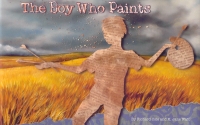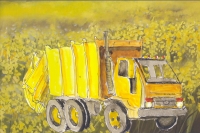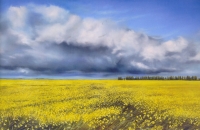| ________________
CM . . .
. Volume XX Number 14. . . .December 6, 2013
excerpt:
The Boy Who Paints is a tale of a young artist’s self-awakening. Artist Richard Cole and writer K. Jane Watt collaborated on the creation of this semi-autobiographical story based loosely on Cole’s journey to becoming an artist. This story will resonate with readers who are visual learners and reluctant readers who are interested in art. At 58 pages, this picture book is on the longer side for younger readers, but there is limited text per page and it is vividly coloured.
Richard Cole’s illustrations, which are mostly oil paintings, have a dreamlike quality but also depth. They are multifaceted and encourage reflection. A motif that carries throughout the book is the boy’s figure. Brushes in hand, he is present in almost every spread. As readers look carefully at the text collage that makes up the boy’s figure, they will notice that it features dictionary definitions relating to the content of the whole illustration; for example, as the boy visually translates the “blue of a sputtering boom lift” (p. 34), his figure features definitions of Prussian blue and cobalt blue. Compositionally, it helps his figure to stand out from the painterly background. It also creates an emotional effect: when readers notice this subtle artistic choice, they are able to experience the same process of discovery and reward as the boy in the story. The strength of the visual storytelling, however, draws attention to the text. The prose is somewhat disjunctive, and a clear vision of the target readers is missing. The text fluctuates between repetitive writing suitable for beginning readers, “He paints them tall. He paints them small” (p. 11), and more sophisticated thoughts, such as “A row of orange hazard cones becomes… the deep horizon of a prairie field” (pp. 42-43). The more advanced descriptions, however, do not match up with a more advanced reader’s meaning-making abilities. In drawing such clear-cut connections between the coloured objects and the landscape paintings, the text undermines the self-discovery and empowerment that is at the heart of the story. Rather than allowing readers to create those connections themselves, they are led to them. Despite this, it is important to note that in these colour sections Watt’s lyrical prose pairs well with the paintings and may inspire young artists to look at the world around them through a different lens. In other spreads, however, the text and illustrations tediously communicate identical, straightforward messages that can be frustrating for younger readers: an illustration of the boy hanging a homemade sign on his door is paired with the text, “He makes a sign for his bedroom door: Art Studio” (p. 7-8). This linear connection flattens the story by preventing readers from looking beneath the surface into the boy’s identity-making as an artist. There is no space for the reader to ponder why the boy made the decision to call himself an artist. While writers are often given the advice to “show, don’t tell,” this particular spread both shows and tells, and in doing so, underestimates the agency of readers to engage with the story and create deeper meaning. Later in the book, the narrator outright states, “I’ll tell you what happens next. It’s simple” (p. 23). While this sort of conversational tone may work in an oral storytelling context, it is almost overly casual and improvised in printed form especially when followed by more literary-style descriptions of canola fields and mountain lakes. The story is supplemented by two information pages at the end of the book: a basic description of colour theory and origins of paint, and a passage on the creative process behind The Boy Who Paints. This additional information is not usually included with Despite these issues, The Boy Who Paints is still a valuable addition to a library due to its appeal to young artistically-minded readers. Learning activities could easily be derived from the story and illustrations. It encourages readers to consider possibilities beyond what they can imagine. Readers in western Canada may also enjoy the local nature of the landscape, and it may act as a point of connection to the story. The Boy Who Paints is a positive, inspiring story with wonderful illustrations. Recommended. Sabrina Wong is a librarian at the University of Calgary in Calgary, AB.
To comment
on this title or this review, send mail to cm@umanitoba.ca.
Copyright © the Manitoba Library Association. Reproduction for personal
use is permitted only if this copyright notice is maintained. Any
other reproduction is prohibited without permission.
NEXT REVIEW |
TABLE OF CONTENTS FOR THIS ISSUE
- December 6, 2013.
AUTHORS |
TITLES |
MEDIA REVIEWS |
PROFILES |
BACK ISSUES |
SEARCH |
CMARCHIVE |
HOME |

 The visual landscape is central to the story. Right at the start, Cole and Watt set the scene in a grey and overcast “town that you know” (p. 1). Watt, who along with Cole, resides in Fort Langley, BC, features maps of their community in the illustrations as a tip of the hat to their local readers. It is a very subtle touch that readers may not notice on a first read but will discover on a second or third. The muted colours very effectively communicate the dreary and flat world the boy inhabits. As the story progresses, the boy begins to see primary and secondary colours, and the illustrations become increasingly colourful as he incorporates them into his landscape.
The visual landscape is central to the story. Right at the start, Cole and Watt set the scene in a grey and overcast “town that you know” (p. 1). Watt, who along with Cole, resides in Fort Langley, BC, features maps of their community in the illustrations as a tip of the hat to their local readers. It is a very subtle touch that readers may not notice on a first read but will discover on a second or third. The muted colours very effectively communicate the dreary and flat world the boy inhabits. As the story progresses, the boy begins to see primary and secondary colours, and the illustrations become increasingly colourful as he incorporates them into his landscape. fictional works, but in this case, it helps to create a fuller understanding for young readers. The process of creating the book passage emphasizes the importance of including works of art: “The boy embodies them, the text relies on them, and the images document their power” (p. 58). The paintings are indeed central to the storytelling; they provide the structural framework for the plot. As described in this passage, the boy progresses from seeing first the primary colours and then the secondary colours with paintings used as examples for each. While this plot is organized in a very logical fashion, in repeating the structure “the [colour] of a [object] becomes… [poetic description],” the story loses its momentum and readers forget about the boy protagonist and his journey to becoming an artist.
fictional works, but in this case, it helps to create a fuller understanding for young readers. The process of creating the book passage emphasizes the importance of including works of art: “The boy embodies them, the text relies on them, and the images document their power” (p. 58). The paintings are indeed central to the storytelling; they provide the structural framework for the plot. As described in this passage, the boy progresses from seeing first the primary colours and then the secondary colours with paintings used as examples for each. While this plot is organized in a very logical fashion, in repeating the structure “the [colour] of a [object] becomes… [poetic description],” the story loses its momentum and readers forget about the boy protagonist and his journey to becoming an artist.